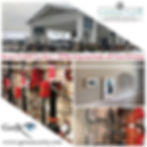Essential Security Features and Technology for Assisted Living Facilities
- GenX Security
- May 17, 2024
- 4 min read
Whether you have an elderly family member already living at or considering assisted living, or you operate an assisted living facility, the safety and well-being of elderly family, friends, and residents is a paramount concern. These facilities house some of the most vulnerable members of our society, making robust security measures essential. The focus on security cameras, access control, and fire/life safety systems cannot be overstated. Here, we explore the critical aspects and advancements in these domains.

SECURITY CAMERAS: Ensuring Constant Vigilance Through the Importance of Surveillance
Security cameras are the cornerstone of any security strategy in an assisted living facility. They serve three primary purposes:
Deterrence: The presence of cameras can deter potential intruders or misconduct by staff and visitors.
Monitoring: Continuous monitoring ensures that any unusual activity is promptly detected and addressed.
Evidence: In case of incidents, recorded footage provides crucial evidence for investigations.
Advanced Features
Modern security cameras come equipped with advanced features that significantly enhance their effectiveness:
High-Resolution Imaging: Cameras with 4K resolution offer crystal-clear images, crucial for identifying individuals and activities accurately.
Night Vision: Infrared or low-light cameras ensure that surveillance remains effective even in low-light conditions.
Motion Detection: Cameras with motion sensors can trigger alerts and recordings only when movement is detected, conserving storage space and highlighting relevant footage.
Remote Access: Facility managers can monitor camera feeds in real-time from any location, ensuring constant vigilance.
AI Integration: Artificial intelligence can be used to recognize patterns, detect unusual behaviors, and even identify specific individuals, improving both proactive and reactive responses.
Strategic Placement
The placement of security cameras is as important as their technical capabilities. Critical areas include:
Entrances and Exits: To monitor who comes in and out, ensuring unauthorized individuals do not gain access.
Common Areas: Such as dining rooms, hallways, and recreational spaces, to monitor interactions and activities.
Perimeters: To detect any attempts to breach the facility’s boundaries.
ACCESS CONTROL: Restricting Unauthorized Entry
Key Technologies
Access control systems are essential for maintaining the safety and privacy of residents. They regulate who can enter specific areas of the facility, ensuring that only authorized individuals have access. Key technologies include:
Key Cards and FOBs: Provide personalized access, track entries and exits, and are a more suitable entry technology for older generations who rely less on smart phone use.
Mobile Access: Smartphones can now serve as access keys, with apps that use encrypted Bluetooth or NFC technology for entry. While older populations may not be as tech-savvy, mobile access credentials would be a reliable technology for management and staff areas.

Integrative Features
Modern access control systems often integrate with other security and facility management systems:
Integration with Surveillance Systems: When access is granted, cameras can be triggered to record the individual entering, providing a comprehensive security log.
Visitor Management: Systems can include visitor management modules, ensuring that visitors are logged, and their access is restricted to certain areas and times.
Safety and Convenience
Effective access control must balance security with convenience:
Emergency Access: Systems should have fail-safes to ensure that doors can be opened quickly in the event of an emergency.
Audit Trails: Comprehensive logs of access events help in monitoring and auditing, providing insights into movement within the facility.

FIRE AND LIFE SAFETY: Protecting Residents from Hazards
Advanced Technologies
Recent advancements have significantly enhanced the effectiveness of fire safety systems:
Smart Detectors: Connected to the facility’s network, these detectors can provide real-time data and alerts to the central management system.
Emergency Lighting and Signage: Clearly marked and illuminated exit routes ensure safe evacuation during emergencies.
Emergency Communication Systems: Intercoms and alarm systems that facilitate communication with residents and staff during a crisis.
Evacuation Plans: Regularly updated and practiced evacuation plans ensure that everyone knows the correct procedures during an emergency.
Training and Drills
Staff training and regular drills are crucial components of a comprehensive fire and life safety strategy:
Staff Training: All staff members should be trained in fire response procedures, the use of fire extinguishers, and how to assist residents during an evacuation.
Regular Drills: Conducting regular fire drills ensures that both staff and residents are familiar with evacuation routes and procedures, reducing panic and confusion during an actual emergency.
In assisted living facilities, the integration of advanced security cameras, sophisticated access control systems, and comprehensive fire/life safety measures is crucial for creating a safe and secure environment for residents. These technologies not only protect against external threats but also ensure the internal safety and well-being of all occupants. By staying at the forefront of security technology and maintaining rigorous safety protocols, assisted living facilities can provide peace of mind to residents and their families, ensuring that their loved ones are in a secure and nurturing environment.
At GenX Security we have expertise in designing, installing, and integrating these systems at assisted living facilities throughout the Upstate. Contact us for a customized fast, fair, and always FREE quote!
Main Line: 866-598-4369


Experience the next generation of interactive security services and solutions with GenX Security.

With custom security integration solutions come custom quotes designed for your needs. Please contact us by clicking here or calling 866-598-4369.








![2020 Roaring Twenties Winner Badge[44136].jpg](https://static.wixstatic.com/media/c44162_312513fcb3514e3ca71a2a18b458369a~mv2.jpg/v1/fill/w_129,h_52,al_c,q_80,usm_0.66_1.00_0.01,enc_avif,quality_auto/2020%20Roaring%20Twenties%20Winner%20Badge%5B44136%5D.jpg)

























